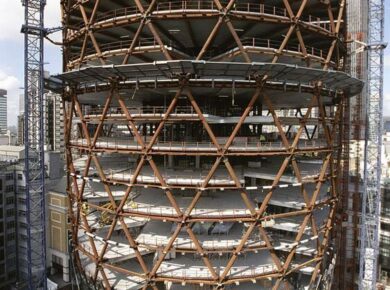Opening of the Oakland Bay Bridge on 12 November 1936.
The San Francisco–Oakland Bay Bridge, is a complex of bridges spanning San Francisco Bay in California. Designed by Charles H. Purcell, and built by American Bridge Company, it opened six months before the Golden Gate Bridge.

Photo: Wikih101
It originally carried automobile traffic on its upper deck, with trucks, cars, buses and commuter trains on the lower, but after the Key System abandoned rail service in 1958, the lower deck was converted to all-road traffic as well.

Photo: InvadingInvader
The western section is a double suspension bridge with two decks. The largest span of the original eastern section was a cantilever bridge. During the 1989 Loma Prieta earthquake, a portion of the eastern section’s upper deck collapsed onto the lower deck and the bridge was closed for a month. Due to earthquake concerns, the eastern crossing was replaced by a new crossing. The western section has undergone extensive seismic retrofitting.

Photo: Oleg Alexandrov
During the retrofit, much of the structural steel supporting the bridge deck was replaced while the bridge remained open to traffic. The entire bridge was fabricated using hot steel rivets, which are impossible to heat treat and so remain relatively soft.

Photo: Daniel Ramirez
Analysis showed that these could fail by shearing under extreme stress. Therefore, at most locations each given rivet was removed by breaking off the head with a jackhammer and punching out the old rivet, the hole precision reamed and the old rivets replaced with heat-treated high-strength tension-control [TC] bolts and nuts.

Source: https://www.loc.gov/pictures/item/ca1352.sheet.00001a
Most of the beams were originally constructed of two plate I-beams joined with lattices of flat strip or angle stock, depending upon structural requirements. These have all been reconstructed by replacing the riveted lattice elements with bolted steel plate and so converting the lattice beams into box beams.

Photo: Leonard G.
This replacement included adding face plates to the large diagonal beams joining the faces of the main towers. Diagonal box beams have been added to each bay of the upper and lower decks of the western spans. These add stiffness to reduce side-to-side motion during an earthquake and reduce the probability of damage to the decking surfaces.
About the Author:

Bruno Dursin – Managing Director at Believe in Steel. Bruno has more than 30 years of experience in promoting steel & steel solutions. His clients benefit from his extensive network within the building industry.



